
Picture Post
April 24, 1943
Hulton’s National Weekly
Vol. 19, No. 4.
PAGE 17-19
SAMARITANS KEEP THE PASSOVER
BY CECIL ROTH.
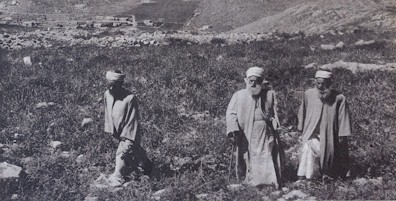 (Page 17) Photo with caption: (Seven Days
Beforehand the High Priest and His Sons Go to the Mountain To prepare
themselves for the Feast of the Passover they walk up mount Gerizim from the
village of Nablus, two miles from Shechem mentioned in the Book of Genesis. The
High Priest wears a new grey robe for the occasion and then puts it aside for ever.)
(Page 17) Photo with caption: (Seven Days
Beforehand the High Priest and His Sons Go to the Mountain To prepare
themselves for the Feast of the Passover they walk up mount Gerizim from the
village of Nablus, two miles from Shechem mentioned in the Book of Genesis. The
High Priest wears a new grey robe for the occasion and then puts it aside for ever.)
The oldest religious rite known to man is carried out about Easter-time by the surviving remnant of the Ten Tribes of Israel. It commemorates the Exodus from Egypt thirty-two centuries ago.
(Photo with caption: (The Community’s
Leader Mazliach ben Pinchas
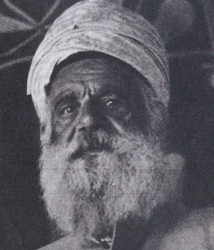 is the highest Samaritan authority on all matters-
religious and worldly.)
is the highest Samaritan authority on all matters-
religious and worldly.)
(Photo with caption: (An Altar is made in
the Prescribed Way: the Field Oven is of Petrol Cans. The members of the
community have cleansed themselves and now the day of the sacrifice has come.
It is 6:30 p.m. The sun is near the horizon. The man on the right holds the
covered knife.)
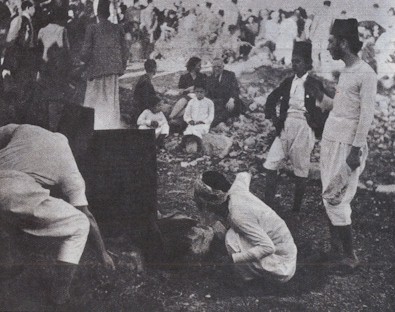 On
the fourteenth day after the New Moon of the first month, which corresponds to
March or April in the European calendar, the remnant of the Samaritans carry
out on the summit of mount Gerizim, 2, 800 feet above sea-level, the oldest
religious rite now known to man.
On
the fourteenth day after the New Moon of the first month, which corresponds to
March or April in the European calendar, the remnant of the Samaritans carry
out on the summit of mount Gerizim, 2, 800 feet above sea-level, the oldest
religious rite now known to man.
The Samaritans are what remain of the Ten Tribes of Israel, who
for centuries divided Palestine with their brethren, the “Jews” of the tribe of
Judah. To-day, fewer than 200 of them remain, huddled together in Nablous, in
the shadow of the site of their former Temple. Once a year only, something of
their former glory returns to them, when they go up the mountain to celebrate
the Passover where their fathers celebrated it for untold generations.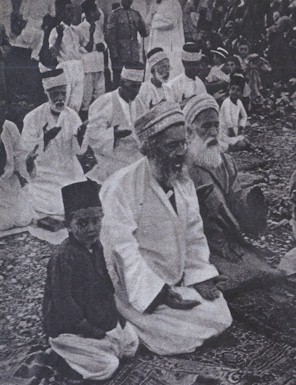
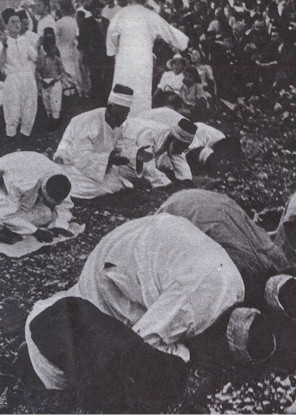 There is no temple now- only the bare summit (page 18) (photo with caption: The
Samaritan Passover: The Initial Prayers. The workers in the background join in
the prayers sung by the priests. Each line is accompanied by a special gesture
of the hands.)
Photo with caption: The Priests Prostrate Themselves. The prostration
requires a careful laying of the hands. The thumbs point inwards and touch the
eyes when heads are bowed.) (photo with caption: The sacrifice of the Pure White Lambs at
the End of the Prayers and Prostration. This is the moment for which the whole
community has prepared itself. On the words “Shall kill,” the lambs without
blemish die at the earthen altar. The carcases are carried on long oak poles to
be roasted at the field oven.)
There is no temple now- only the bare summit (page 18) (photo with caption: The
Samaritan Passover: The Initial Prayers. The workers in the background join in
the prayers sung by the priests. Each line is accompanied by a special gesture
of the hands.)
Photo with caption: The Priests Prostrate Themselves. The prostration
requires a careful laying of the hands. The thumbs point inwards and touch the
eyes when heads are bowed.) (photo with caption: The sacrifice of the Pure White Lambs at
the End of the Prayers and Prostration. This is the moment for which the whole
community has prepared itself. On the words “Shall kill,” the lambs without
blemish die at the earthen altar. The carcases are carried on long oak poles to
be roasted at the field oven.)
(Page 19)
(Photo with caption: The Priests Offer the Sacrifice.
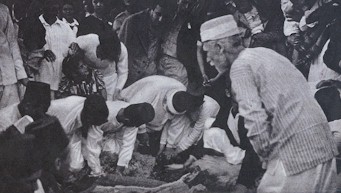 Their
faces turned to the altar, the High Priest and the last High Priest’s son
announce the institution of the Passover.) with its outcropping of rock. Before the
celebration the entire community- men, women and children- move from their
homes and pitch their tents on the mountain top, and here they carry out the
ancient Passover ritual, as the Bible prescribes it (Exodus xii, verses 1 to
24). To serve as altar, a trench is dug, about 9 ft. long and 3 ft wide,
and is lined with rough stones. On the fourteenth day of the month, as the sun
begins to go down, a fire is kindled in the trench, boiling water is prepared
in cauldrons, and the venerable High Priest, taking his stand on a platform,
with the congregation ranged behind him in rows in order of seniority, begins
Their
faces turned to the altar, the High Priest and the last High Priest’s son
announce the institution of the Passover.) with its outcropping of rock. Before the
celebration the entire community- men, women and children- move from their
homes and pitch their tents on the mountain top, and here they carry out the
ancient Passover ritual, as the Bible prescribes it (Exodus xii, verses 1 to
24). To serve as altar, a trench is dug, about 9 ft. long and 3 ft wide,
and is lined with rough stones. On the fourteenth day of the month, as the sun
begins to go down, a fire is kindled in the trench, boiling water is prepared
in cauldrons, and the venerable High Priest, taking his stand on a platform,
with the congregation ranged behind him in rows in order of seniority, begins
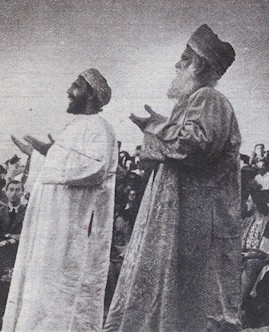 to recite hymns of immemorial antiquity and the passages of the Book of Exodus
relating to the deliverance of the children of Israel from Egypt and the
celebration of the Passover.
to recite hymns of immemorial antiquity and the passages of the Book of Exodus
relating to the deliverance of the children of Israel from Egypt and the
celebration of the Passover.
Some days before, a
number of pure white lambs- “males of the first year without blemish:- have
been set aside for the sacrifice. Nowadays, there are generally seven of them,
one for each (photo
with caption: The Passover Moon Rides High Over the Gate of Heaven.
It is nearly midnight when the Samaritan families on the mount known as the
Gate of heaven eat the sacrificial meat. Every scrap left over be burned by
fire.) (Photo
with caption: A Priest Takes Away the Sacrificial Knife. He
contemplates the sacrifice, surrounded by the members of the community and some
Australian troops.) of the clans into which the Samaritan remnant is divided. Just
before sunset, the entire company
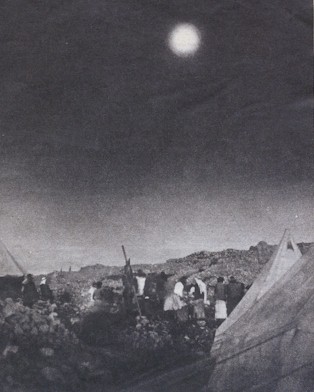 closes round the “altar.” When the passage is
reached “and the whole assembly of the congregation of Israel shall kill it in
the evening” (Exodus xii.6) the lambs are brought into the enclosure by
white-clad youths wearing sandals. Three of them hold each animal in position,
and after the High Priest has inspected it to see that it is without blemish,
an ordinary priest cuts its throat, with a single deft stroke of his
razor-sharp sacrificial knife. Some of the blood is caught in a little bowl in
which a bunch of wild thyme or hyssop is stirred, so as to mark the tents as a
sign to the Angel of Death.
closes round the “altar.” When the passage is
reached “and the whole assembly of the congregation of Israel shall kill it in
the evening” (Exodus xii.6) the lambs are brought into the enclosure by
white-clad youths wearing sandals. Three of them hold each animal in position,
and after the High Priest has inspected it to see that it is without blemish,
an ordinary priest cuts its throat, with a single deft stroke of his
razor-sharp sacrificial knife. Some of the blood is caught in a little bowl in
which a bunch of wild thyme or hyssop is stirred, so as to mark the tents as a
sign to the Angel of Death.
The animals are firmly held, head downwards, for ten to fifteen
minutes, until the blood has completely drained out.
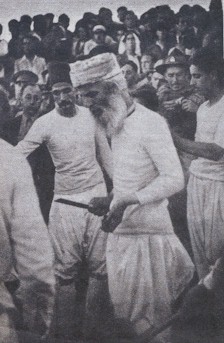 The carcases are then
scalded and prepared, transfixed from end to end on long oak poles which serve
as spits, and taken to a primitive field-oven made ready a little way off. Here
they are covered over with clay and left to roast for some three hours. There
is now a break in the proceedings, most of the company retiring to their tents
to rest: while others entertain the strangers to coffee in the big reception
tent, for the ceremony has been thoroughly commercialized in recent years. The
night is far advanced when the congregation is summoned to the next stage of
the proceedings- generally about midnight, though, under the rays of the
pellucid Palestinian full-moon, it is nearly as light as day. The heads of
families, led by the High Priest, make a procession to the oven, each carrying
a straw basket. The clay is broken and the roast meat removed and brought back
to the altar to be eaten by the community with the statutory unleavened bread
and bitter herbs. Each family forms a circle by itself- men in front, women
behind- all standing, with their loins girt up, their shoes on their feet and
their staffs in their hands (Exodus xii. Verse 2), and tearing the meat apart
in their hands as a sign of haste. Not a scrap is left over, any residue or
portions which cannot be eaten, or even crumbs which have fallen to the ground,
being burned religiously by fire.
The carcases are then
scalded and prepared, transfixed from end to end on long oak poles which serve
as spits, and taken to a primitive field-oven made ready a little way off. Here
they are covered over with clay and left to roast for some three hours. There
is now a break in the proceedings, most of the company retiring to their tents
to rest: while others entertain the strangers to coffee in the big reception
tent, for the ceremony has been thoroughly commercialized in recent years. The
night is far advanced when the congregation is summoned to the next stage of
the proceedings- generally about midnight, though, under the rays of the
pellucid Palestinian full-moon, it is nearly as light as day. The heads of
families, led by the High Priest, make a procession to the oven, each carrying
a straw basket. The clay is broken and the roast meat removed and brought back
to the altar to be eaten by the community with the statutory unleavened bread
and bitter herbs. Each family forms a circle by itself- men in front, women
behind- all standing, with their loins girt up, their shoes on their feet and
their staffs in their hands (Exodus xii. Verse 2), and tearing the meat apart
in their hands as a sign of haste. Not a scrap is left over, any residue or
portions which cannot be eaten, or even crumbs which have fallen to the ground,
being burned religiously by fire.
In the morning, the Samaritans begin the celebration of the Feast of Unleavened Bread, which lasts for seven days, so that they spend nearly a fortnight in all on the mountain top, where sometimes children are born during the proceedings.
Thus is performed, with all the ancient rites, the religious ceremony in commemoration of the Exodus of the Children of Israel from Egypt thirty-two centuries ago. CECIL ROTH